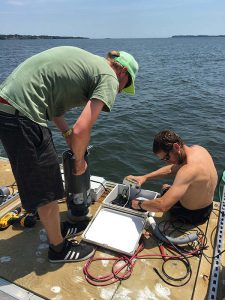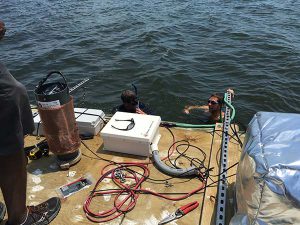On a bright and sunny July day, IOOSians met up on Solomons Island in the Chesapeake Bay to see research and development translated to operations first hand!

The entry gate to the University of Maryland Chesapeake Bay Research Pier. Photo Credit: NOAA/IOOS
Since 2015, the Alliance for Coastal Technologies (ACT) has led the Nutrient Sensor Challenge in partnership with the Office of Science, Technology, and Policy (OSTP); the U.S. Environmental Protection Agency (EPA); the United States Geological Survey; and the Department of Agriculture. The Nutrient Sensor Challenge is a market-based competition designed to spur innovation by issuing a challenge to create low cost sensors for measuring dissolved nitrate and/or phosphorous. The idea is, if new sensors can be made available to the scientific community at an affordable price point, research can expand and grow, which will improve our nation’s ability to observe and monitor coastal and ocean waters. ACT states that “the data from these sensors will be used for a variety of purposes, including monitoring and basic research on nutrient dynamics in aquatic ecosystems, trends assessments in impaired or target waterbodies, and evaluations of mitigation or restoration efforts.”

Maxime Grand working on the National Oceanography Centre's (NOC) sampling units. Photo Credit: NOAA/IOOS
The challenge kicked off nearly a year ago and with five teams from all over the world designing to meet the competition objectives: a sensor that can continuously monitor the nutrient content of sea water for 3 months unattended, transmit data in real-time, and is available to the consumer at $5,000 or below. Once the prototypes were ready, the deployment stage began. In spring 2016 there was a 3-month deployment in the freshwater of the Great Lakes. Lessons learned and prototypes adjusted, the teams have now moved onto their brackish water challenge: 3-months in the Chesapeake Bay at the ACT facility at the University of Maryland Chesapeake Biological Laboratory on Solomons Island. Once this step is complete, the final test--salt water in Hawaii--will be the final test for these new sensors. During this brackish water challenge, the IOOS program office was able to visit the deployment site and talk shop with the teams.
The day began with a briefing kicked off by Tom Miller, Director of the UMD Chesapeake Biological Laboratory and Denice Shaw, EPA Office of Research and Development, along with Beth Stauffer (University of Louisiana Lafayette), and Earle Buckley (ACT). Dr. Stauffer, who has been involved in this project since its inception, related that some commercially mature companies not involved in this challenge had told ACT that this challenge has similarly spurred their own innovations—seeking to provide competitive sensors at an accessible cost. (This challenge is open to all, though some chose to work independently because of their production timelines and schedules might not have matched up with this challenge.)

Visitors watching from the pier as the equipment is installed. The man holding a pole in the foreground is busy scooping sea nettles away from the team in the water! Photo Credit: NOAA/IOOS
Tom Johengen, (U. Michigan and Cooperative Institute of Limnology and Ecosystems Research) then stepped in to play lead coordinator for the day, including a short tour of each vendor’s instrument preparations; mid-day and afternoon deployments off the ACT / CBL pier; and a review of the data streams flowing from the newly deployed sensors. For the IOOS team, this was a much-anticipated opportunity to engage with vendors and PIs in a collaborative, informal environment where shared excitement over R&D affected everyone. “It was amazing to see the variety of ways the teams were innovating to overcome the challenges of monitoring conditions in salt water,” said Carl Gouldman, IOOS Deputy Director.

Readying for deployment: assembling the NOC experiment electronics on the pier. Photo Credit: NOAA/IOOS
Only two of the five sensors are being derived from previously commercialized technologies, and the vendors indicated that the challenge has pushed them to think in new ways to achieve the objectives of the challenge. A visit during the second deployment phase was particularly interesting, as the challenge teams had already executed their freshwater deployment in the Great Lakes and the IOOS office got to see and hear how they were working with issues that arose during that time as well. Of particular interest was seeing how they all were addressing biofouling, one of the chief obstacles to overcome to allow for lengthy in-water use. From fine copper mesh to prevent biofouling to utilizing pelican cases for long-term support of surface tech, there were lots of good ideas on deck.
Next up: three months deployment in the salt water of the Pacific off Hawaii, and then to market!

IOOSians Deputy Director Carl Gouldman, Grants Officer Regina Evans, and LCDR Eric Johnson walk out to the sampling example location at end of the pier. Photo Credit: NOAA/IOOS
 Official websites use .gov
A .gov website belongs to an official government organization in the United States.
Official websites use .gov
A .gov website belongs to an official government organization in the United States.
 Secure .gov websites use HTTPS
A lock or https:// means you’ve safely connected to the .gov website. Share sensitive information only on official, secure websites.
Secure .gov websites use HTTPS
A lock or https:// means you’ve safely connected to the .gov website. Share sensitive information only on official, secure websites.


